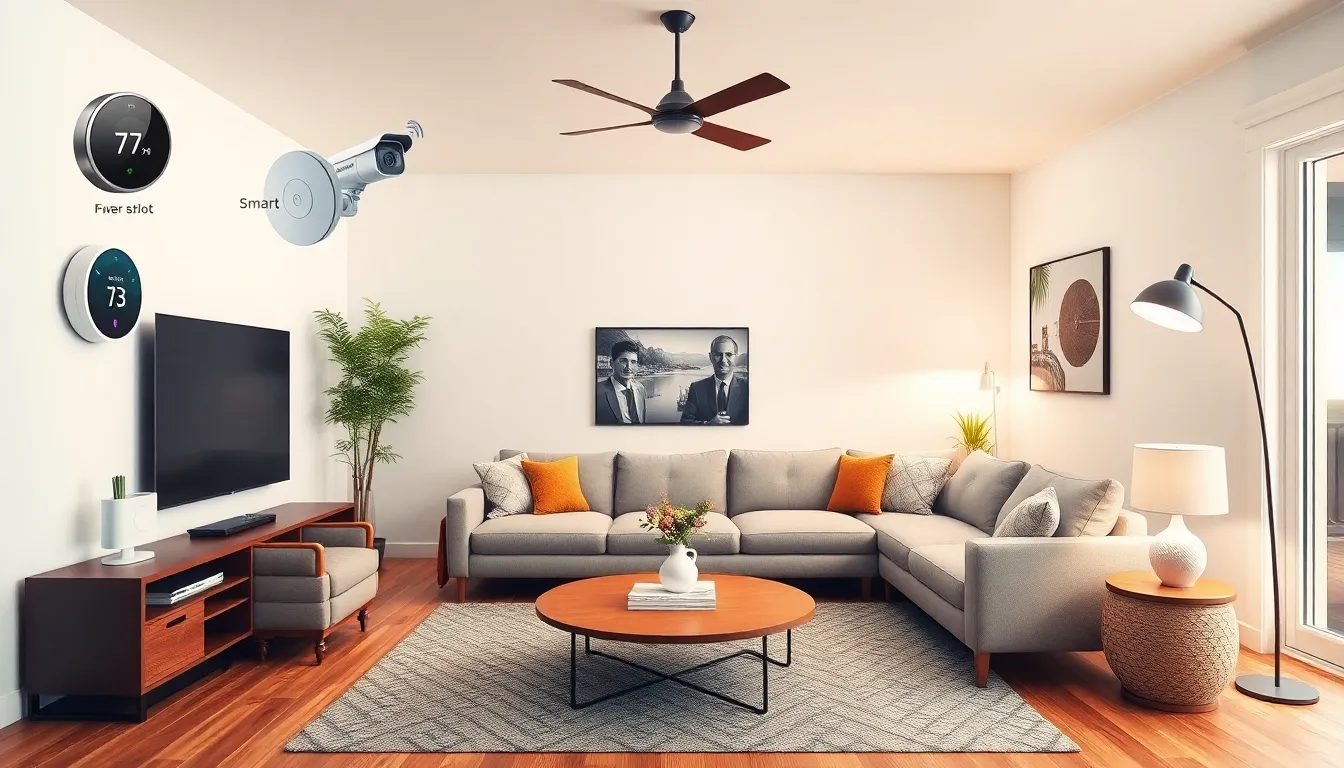Table of Contents
ToggleImagine waking up to the gentle hum of your coffee maker and the soft glow of your favorite lamp, all without lifting a finger. Welcome to the world of home automation, where smart devices are not just gadgets but your new best friends. As technology evolves faster than a cat video goes viral, homeowners are embracing these innovations to make life easier, safer, and a whole lot cooler.
Overview of Home Automation Trends
Current home automation trends focus on enhancing convenience, security, and sustainability. Smart home devices, such as thermostats, locks, and lighting systems, see increased adoption among homeowners. Integrating artificial intelligence into these devices allows for personalized experiences, making daily routines more efficient.
Voice-activated assistants gain popularity, enabling users to control devices hands-free. Many households now incorporate smart speakers, which connect to various home automation systems, providing easy access to features. Sensors for environmental monitoring, such as smoke and carbon monoxide detectors, ensure safety while offering peace of mind.
Smart energy management becomes essential as homeowners seek to reduce utility costs. Automated systems can help optimize energy consumption through real-time data analysis and remote management. Energy-saving devices, including smart plugs and solar power systems, also reflect this trend.
Homeowners increasingly prioritize interoperability among devices. The development of unified platforms allows diverse products to work together seamlessly. Users benefit from greater control and convenience when managing multiple systems through a single app.
The emergence of home automation in rental properties signals a shift in market dynamics. Property owners recognize the value of smart technology in attracting tenants. Features like smart locks and climate control systems stand out in competitive rental markets.
Finally, privacy concerns remain a key consideration in the implementation of home automation devices. Consumers demand enhanced security measures to protect their data. Manufacturers respond by improving encryption methods and transparent privacy policies, ensuring user confidence in their products.
Emerging Technologies in Home Automation

Home automation continues to evolve, driven by advancements in technology. Two key areas include the integration of smart devices and the utilization of artificial intelligence.
Smart Devices and IoT
Smart devices, connected through the Internet of Things (IoT), revolutionize home automation. Such devices include smart thermostats, security cameras, and lighting systems, which work collaboratively to enhance user experience. Data from various sensors allows these devices to function intelligently, adapting to the homeowner’s preferences. Flexibility and convenience characterize a smart home environment where routines become effortless. Remote access enables users to monitor their homes from anywhere, maintaining control and enhancing security. Increased interoperability ensures that diverse devices can communicate effectively, streamlining user interaction.
AI and Machine Learning Applications
Artificial intelligence applications play a pivotal role in home automation trends. Machine learning analyzes user behavior, tailoring device responses to individual preferences. Customizations, like adjusting temperature settings or lighting, occur based on historical data, enhancing comfort. Voice-activated assistants also leverage AI, facilitating hands-free control over smart devices. Predictive analytics contribute to energy management, optimizing consumption and reducing costs. As AI technology advances, the potential for increased efficiency in home automation continues to grow, providing homeowners with smarter, more intuitive systems.
Sustainability and Energy Efficiency
Home automation trends increasingly focus on sustainability and energy efficiency. Smart technologies play a pivotal role in reducing energy consumption and minimizing environmental impact.
Renewable Energy Integration
Integrating renewable energy sources enhances energy independence for homeowners. Solar panels represent a popular choice, generating electricity while reducing reliance on non-renewable sources. Wind turbines, where feasible, provide another clean energy option. Homeowners utilize battery storage systems to harness solar energy for later use, optimizing efficiency. Governments often incentivize these installations, promoting sustainable practices. As the demand for eco-friendly solutions grows, smart home systems that tap into renewable sources are becoming mainstream.
Smart Energy Management Systems
Smart energy management systems analyze real-time data to optimize energy usage. These systems allow homeowners to monitor consumption patterns and adjust settings accordingly. Automated thermostats adapt to user routines, maximizing efficiency while ensuring comfort. Lighting systems, programmed to turn off in unoccupied spaces, contribute further to energy savings. Integration with renewable sources amplifies these benefits, enabling efficient energy distribution throughout the home. The result is significant cost reductions, demonstrating the financial advantages of adopting smart energy management systems.
Enhanced Security Features
Home automation innovations prioritize security through advanced features and smart devices designed to protect residences. Homeowners embrace these technologies to enhance their safety.
Advanced Surveillance Systems
Advanced surveillance systems are becoming indispensable for modern homes. High-definition cameras provide clear images, while motion detection alerts offer timely information about unusual activity. Continuous video recording capabilities ensure extensive coverage, allowing homeowners to review footage anytime. Remote access to camera feeds enables monitoring from anywhere using a smartphone or tablet. Many systems incorporate artificial intelligence to distinguish between familiar faces and potential intruders, further enhancing security measures. The evolution of surveillance technology also emphasizes seamless integration with other home automation devices, creating a united security ecosystem.
Smart Locks and Access Control
Smart locks and access control systems enhance security by providing keyless entry solutions. Homeowners appreciate the convenience of managing access through mobile apps or smart assistants. Several smart locks offer features such as temporary access codes, allowing homeowners to grant visitors entry without physical keys. Remote locking and unlocking capabilities ensure peace of mind, particularly during emergencies. Integrating these systems with existing home automation setups can allow for personalized security settings and real-time alerts. As smart locks evolve, they continue to include advanced encryption and biometric identification, ensuring increased protection against unauthorized access.
User-Centric Design and Experience
User-centric design prioritizes the needs and preferences of individuals in home automation. Innovations enhance usability and simplify interactions with smart devices.
Voice-Activated Interfaces
Voice-activated interfaces transform user experience. These interfaces enable hands-free control for various home automation tasks such as adjusting thermostat settings or controlling lighting. Popular devices like Amazon Echo or Google Nest allow seamless communication between users and smart systems. Voice commands facilitate accessibility for all users, offering convenience to those with mobility challenges. Continuous improvement in natural language processing enhances the accuracy of voice recognition, making interactions more intuitive.
Customizable Automation Solutions
Customizable automation solutions cater to specific user needs. Users can tailor settings for lighting, thermostat schedules, and security systems through user-friendly apps. Options like setting different lighting scenes for movie nights or adjusting temperature during bedtime allow personalized environments. Flexible automation ensures products integrate smoothly into users’ routines. Smart home systems adapt to individual schedules, promoting efficiency and comfort in daily life. With these capabilities, homeowners easily create a tailored experience that aligns with their lifestyles.
Home automation is reshaping the way people live by providing unparalleled convenience and security. As technology continues to evolve, smart devices are becoming integral to daily routines. The focus on sustainability and energy efficiency highlights a significant shift in consumer priorities, making eco-friendly solutions more appealing.
With advancements in artificial intelligence and IoT, homeowners can expect even more personalized and intuitive experiences. Enhanced security features ensure peace of mind while user-centric designs make technology accessible to everyone. As these trends gain momentum, the future of home automation looks promising, paving the way for smarter, safer, and more efficient living environments.




